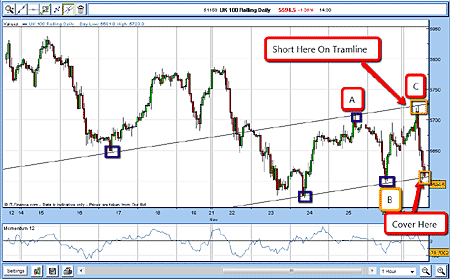Day-trading the FTSE 100 using my tramline trading method
My tramline trading method for spread betting is very versatile. Here's an example of a trade in the FTSE 100, which was over in a just few hours on Monday 29 November.
My tramline trading method for spread betting is very versatile. Here's an example of a just-completed trade in the FTSE 100, which was over in a just few hours on Monday 29 November.
The weekend's news was taken up by the International Monetary Fund and eurozone 'rescue' package agreement for Ireland. The markets opened barely changed from Friday's close. Then, when the market did not immediately sell off, it began a tentative rally.
As a spread betting trader, you need to be aware of what the market is expecting (what news it is already pricing in); what you expect the market to do under this scenario; and then take a step back and ask yourself is the market reacting correctly? If not, then something is amiss and a profit opportunity beckons.
MoneyWeek
Subscribe to MoneyWeek today and get your first six magazine issues absolutely FREE

Sign up to Money Morning
Don't miss the latest investment and personal finances news, market analysis, plus money-saving tips with our free twice-daily newsletter
Don't miss the latest investment and personal finances news, market analysis, plus money-saving tips with our free twice-daily newsletter
Early on Monday, I was plotting the hourly FTSE chart and I saw that I could draw a very nice pair of tramlines:

The purple boxes show the points already made by the chart before my trade, through which I drew my lines. For the upper tramline, I had a superb pivot point at the low on 17 November, which took it through the high on the 25th. For the lower tramline, I had the lows on the 14th and 26th.
So on the 29th, as the market rallied past the 5,700 level, it was getting very close to hitting my upper tramline.
I then entered a resting sell order at 5,720.
How much risk would I take? I reckoned that if the market carried on to the 5,750 level, that would negate my tramline construction. My risk, I decided, was to be 30 pips.
That's a very tight stop, in most situations. But this was not a normal situation.
I was confident that my tramlines would hold with a high degree of accuracy. Also, there was a clear three-wave Elliott pattern up from the 24 November low.
As you probably know by now, a three-wave sequence is counter-trend. So I expected the bear market to resume after the third wave. Hopefully, that would occur right on my upper tramline! So I decided to trade £4 a pip. My order was quickly filled (at point 'C' on the chart above).
29 Nov sold £4 rolling FTSE @ 5,720.
Stop @ 5,750.
Risk £120 (2.4% of account)
Right away, the market plunged, which is always exciting. Now I had my downside target the lower tramline.
Glancing at the chart, I thought that would likely be 5,603. But in case the support came in just ahead of the tramline, I decided to set 5,610 as my target, and entered a resting buy order there to cover my trade. In the meantime, I lowered my protective stop to break-even using my break-even rule.
I didn't have long to wait. My order was filled around mid-morning for a very quick and clean trade:
29 Nov covered £4 rolling FTSE @ 5,610.
Profit £440 on risk of £120
I am finding that recently, I am seeing a lot of very reliable tramline set-ups in all timeframes in the large markets that I follow (primarily, stock indices, gold, silver, and currencies). I would encourage any spread betting trader to regularly search the charts for them.
If you can draw at least two parallel tramlines using a pivot point from a previous period, as I did here, so much the better, as it adds more confidence to the validity of your line.
Remember, the tramlines represent barriers to the market.
Incidentally, the shortest timeframe I like to trade with is the 30-minute. This gives me room to think. I know that many day-traders go down to the one-minute and two-minute charts. That is a little too intense for me! But by all means, explore these timeframes, and I'm sure you will be amazed at what you will find in your charts.
Get the latest financial news, insights and expert analysis from our award-winning MoneyWeek team, to help you understand what really matters when it comes to your finances.
John is is a British-born lapsed PhD physicist, who previously worked for Nasa on the Mars exploration team. He is a former commodity trading advisor with the US Commodities Futures Trading Commission, and worked in a boutique futures house in California in the 1980s.
He was a partner in one of the first futures newsletter advisory services, based in Washington DC, specialising in pork bellies and currencies. John is primarily a chart-reading trader, having cut his trading teeth in the days before PCs.
As well as his work in the financial world, he has launched, run and sold several 'real' businesses producing 'real' products.
-
 Pundits had a bad 2025 – here's what it means for investors
Pundits had a bad 2025 – here's what it means for investorsThe pundits came in for many shocks in 2025, says Max King. Here is what they should learn from them
-
 The MoneyWeek ETF portfolio – early 2026 update
The MoneyWeek ETF portfolio – early 2026 updateThe MoneyWeek ETF portfolio had a solid year in 2025 and looks well placed for what the next 12 months may bring